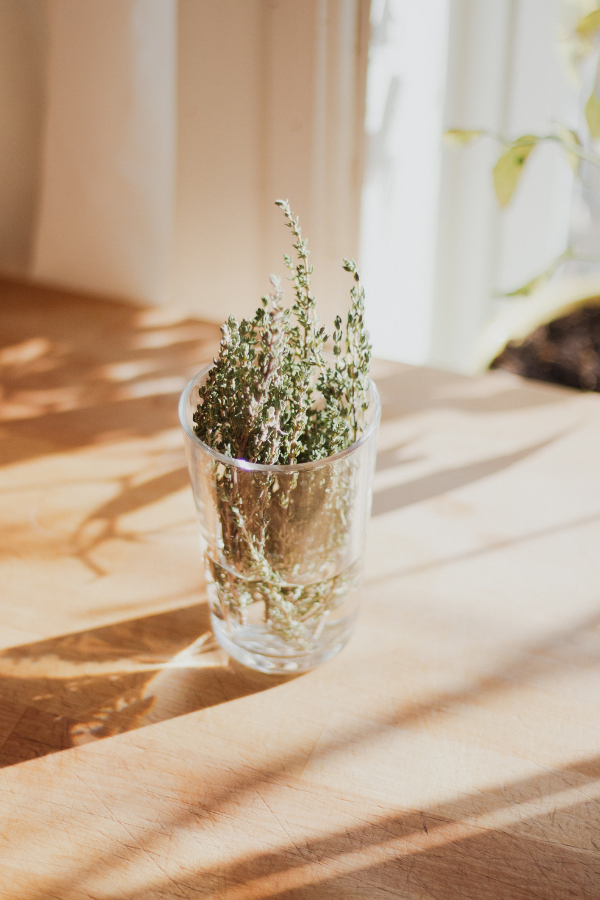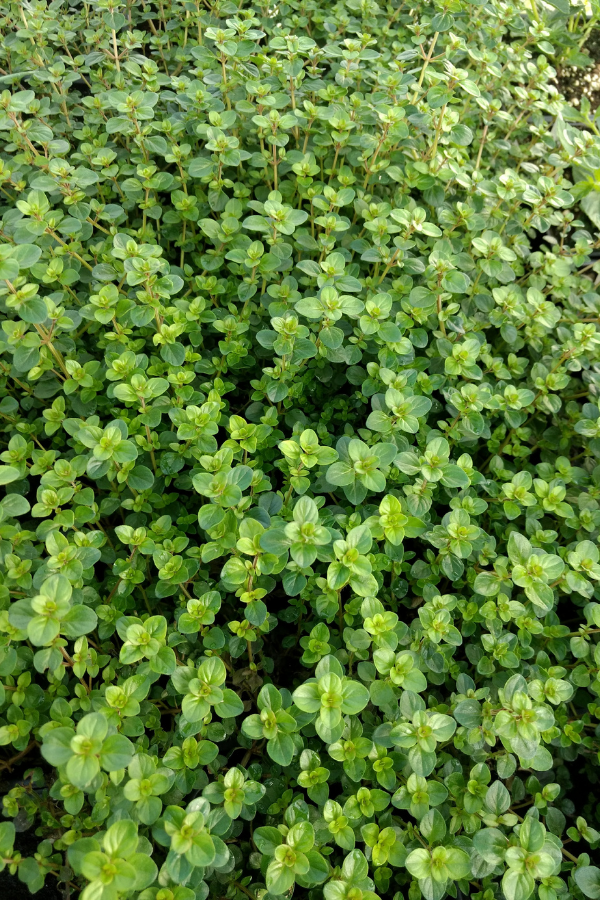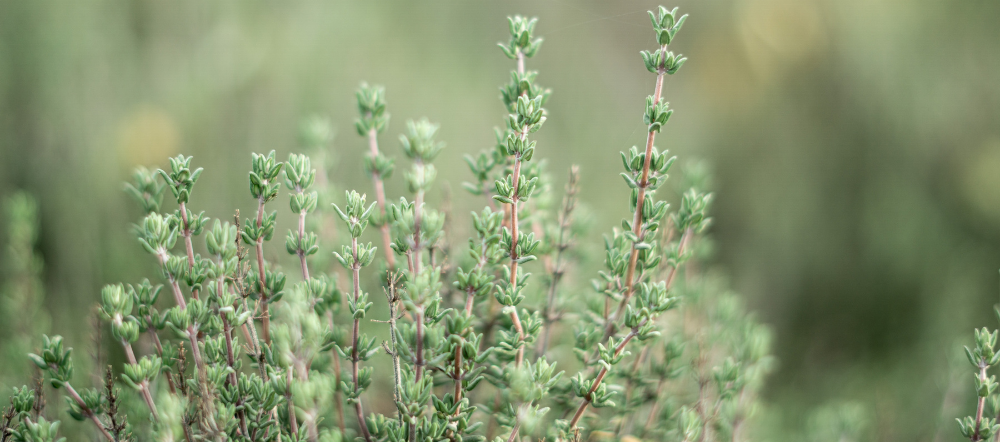Thyme is a popular herb grown by many gardeners for its fresh aroma, culinary purposes, and ease of care.
Thyme can be expensive to buy fresh in the store if you need it often, so why not grow your own for free? Especially since thyme grows faster than some other plants (it’s similar to other herbs in this area).
As a cousin to the oregano plant, the process for propagating thyme is going to look similar to how you would grow oregano from cuttings. Thyme is also part of the mint family of plants and is almost as easy to grow as mint.
Before we jump into how to grow thyme from cuttings, it’s important to note that if you have a thriving thyme plant, you may not need to take cuttings as described below at all. Thyme tends to spread and root down with its offshoots. If the offshoot is established enough, it can be cut from the mother plant and planted by itself.
To jump to a specific step in this process, click a link below:
- Get a hold of some thyme
- Strip the leaves off the bottom of the stems
- [Optional] Apply growth hormone
- Start the root structure
- Wait 6-8 weeks for the plant to mature
- Care for your new thyme plant
What is thyme?
You’ve likely used this herb while cooking before, or at lFeast ate a dish that included thyme. Thyme is often used in dishes such as seasoning for sauces or soups. It can also be used in other ways in the kitchen, such as paired with other herbs in potato or poultry dishes.
Like many other herbs, thyme can easily be grown in many growing zones in the United States. In PA’s growing zones (where we grow plants), thyme grows great. Thyme is a great addition to any herb garden, with its green foliage color and the reward of some fresh herb for your kitchen!
But how do you start?
While growing thyme from seed is certainly an option, growing thyme from cuttings can be an interesting experience and doesn’t even require you to own a thyme plant.

Can thyme be grown from cuttings?
Yes, thyme can be grown cuttings, also known as propagating thyme. Propagating simply means producing a plant that is identical (genetically speaking) to its parent by means of dividing, taking cuttings, etc.
No matter what kind of thyme (English thyme, etc.) you are growing from cuttings, it’ll likely take the same steps to propagate.
Let’s dive into how you can grow thyme from cuttings.
How to grow thyme from cuttings
To grow thyme from cuttings, you’ll need:
- A small pot (around 3″ size will do — and make sure it has good drainage)
- Water
- Rooting hormone (optional)
Before we get into the specific steps, it should be noted that growing thyme from cuttings is a lengthy process. If a rooting hormone is used, it could take as long as a year until you can harvest and eat from your new thyme plant.

Step-by-step on how to propagate thyme
Here’s a rundown of everything involved with growing thyme from cuttings.
1. Get a hold of some thyme
To start, you’ll need some thyme cuttings of course.
If you are growing your own thyme, simply cutting off some healthy, non-flowering sprigs of thyme will do — sprigs that are 4-6″ long will be great!
Make sure you take plenty of cuttings — it’s unlikely that all of your thyme sprigs will survive when propagated.
You can take cuttings any time throughout the growing season, but the best time is during its active growth season, which is any time between spring and fall.
I prefer to propagate thyme in the spring so that the young plants have plenty of time to establish themselves before winter when it can be more difficult to grow. Thyme stems are also more likely to be tender in the spring, which is more preferable than woodier stems for propagating.
I would also recommend using a scissors to make your cuttings so that there is a nice clean cut.
If you aren’t currently growing thyme and don’t know of anyone who is willing to share theirs, most grocery stores or farmers’ markets sell packs or bunches of fresh thyme. While it’s preferable to cut sprigs straight from a plant, sprigs purchased are fine as long as they are fresh.
2. Strip leaves off bottom 2″ of the thyme sprig
Once you have a thyme sprig, strip off the leaves on the lower end of the stem — you’ll want about 2″ of the bare stem, which will serve as the base for future roots. You can strip the leaves off with your fingernails.
If possible, include at least 2-3 “nodes” on the thyme sprig. These are the joints of the sprig where new leaves and stems branch out. This is also where a new root structure will be the easiest to start from.
If you are ready to propagate the sprig right away, cut the tip of the thyme sprig at a 45-degree angle. This will ensure some fresh exposure to the center of the sprig.
Some gardeners will “top” the sprig. This means they snap off the growing end of the sprig so promote growth in its roots. I haven’t done this when propagating but it can be done.

3. [Optional] Dip the stem into a growth hormone
At this point, you have the option of dipping the sprig’s bare stem into a rooting hormone.
Using a growth hormone is optional, especially when it comes to thyme, which you’ll likely be consuming down the road. In some cases, it may be necessary for healthier roots, but in many cases, you can get by without it.
Some gardeners also use honey as a natural rooting hormone, but I don’t have any experience with that. I normally go without the rooting hormone. It can lower the survival rate of the cuttings, though.
If you do want to use a growth hormone for a faster and healthier root system, you can purchase either the powder or gel form at your local garden center. Then, simply dip your stem into some water and place the tip of the sprig into the growth hormone.
Please note: When propagating thyme with a rooting hormone, keep in mind that most hormones (whether in powder or gel form) will require you to wait until a full year before consuming any part of the plant. Be sure to read the label on the growth hormone you purchase for more detailed use.
4. Start the root structure
If you chose to start the plant with a growth hormone, you can plant the stem in a potting soil mix to ensure that it has good draining. Thyme that is grown in a pot without any drainage is susceptible to diseases that could kill the plant, such as root rot.
Since these are just little sprigs at this point, planting them in a small pack or pot is preferable. This will allow you to move the plant around if needed.
If you aren’t using a growth hormone, you’ll want to establish a root structure before planting in soil. To do this, you can place your thyme plant in a glass of water, with the 2″ of bare stem fully submerged. Make sure the top portion of the stem is still above water, though.
Some people recommend swapping out the water every 5-6 days to keep the sprigs fresh.
After 3-4 weeks you should start seeing roots sprouting out of the stem!
Once you have some mature roots, the plant is ready to plant in potting soil. Since the thyme plant is used to the water, make sure that the soil you are planting it in is very moist — this will reduce the thyme’s transplant shock. Also, make sure the sprig’s stem has good contact with the soil so that the root system can grow immediately into the soil.
5. Wait 6-8 weeks for the maturing plant
Depending on what time you are propagating, the time it will take to root up and grow will vary. Typically, after 6-8 weeks you’ll start seeing some indicators of growth.
It’s best to store your thyme plant in a warm, humid area. If you have a greenhouse, this climate is perfect. If not, you can achieve the same effect by putting a plastic bag over the plant and container. Depending on the outside climate that you are growing in, keeping the plant outside may be good enough.
I know some gardeners will also cover the young plant with a clear plastic container to create the same “greenhouse effect” and promote thyme growth that way.
If you notice that the leaves start to turn yellow, brown, or black after a few weeks, it may be due to transplant shock (much like us humans, plants don’t like sudden change). In this case, simply trim off the yellow leaves and prepare for more growth.
6. Care for your new thyme plant!
Now that you have your plant started, it’s time to start treating it like any young plant you would purchase at a greenhouse or growing center. Make sure the thyme plant gets plenty of sunlight and water (keeping the top level of soil damp is great).
Here’s more information on how often to water your herb plant, or specifically how often to water a thyme plant.
Eventually, the thyme plant will outgrow its original pot and you can plant this perennial directly in the ground for thyme for years to come!

Summary: growing thyme from cuttings
To summarize, thyme is a great herb to try growing from cuttings! To propagate your thyme, you can follow these steps:
- Get a hold of some thyme
- Strip the leaves off the bottom of the stems
- [Optional] Apply growth hormone
- Start the root structure
- Wait 6-8 weeks for the plant to mature
- Care for your new thyme plant

